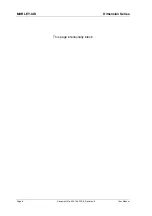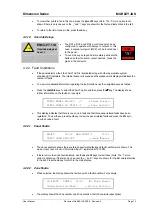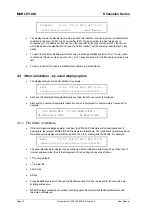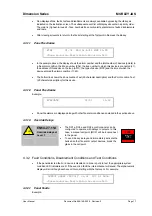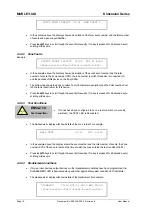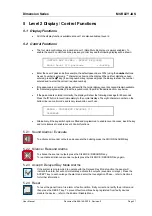
Dimension Series
MORLEY-IAS
User Manual
Document No.996-148-000-5, Revision: 5
Page 9
•
The Level 1 LED Indicators are divided into three blocks as described in Table 3 opposite. The LED
Indicators illuminate as red, yellow or green.
•
Block 1 contains LED Indicators showing the state of the fire alarm control panel.
•
Block 2 contains LED Indicators showing specific fault conditions. In addition, there are two
programmable indicators.
•
Block 3 contains the Zone Fire LED Indicators. There are either 20 or 40 LED Indicators depending on
the model.
3.3 Alphanumeric Display Indications
•
The alphanumeric liquid crystal display (LCD) gives 80 characters of information on a 2-line display.
The display is illuminated to assist viewing under dim ambient light conditions.
3.3.1 Normal
Condition
•
If the panel is in the quiescent condition the display shows the day of the week, date and time (24hour
format) as follows:
Wed 07/05/2003 11.38:59
All devices are inside working limits
3.3.2 Other Conditions
3.3.2.1 Loop Device Faults/ Fires
•
The alphanumeric display will automatically update to show zonal information about the latest device
to enter a fault or fire condition.
•
IN FAULT ZONE 1 1/1 X:Summary
<
ZONE TEXT
>
→
: Device Details
•
Use the right arrow key to view the individual device/point details within the affected zone.
•
Use the up/down arrow keys to view different zones in the same condition.
•
Use the ‘X’ key to exit the summary display.
3.3.2.2 F1 Short-cut Navigation Key
•
Where the F1 function key is not programmed to provide a specific function e.g. Bomb alert, Class
change etc, it will operate as a navigation shortcut key.
•
Press the ‘F1’ function key once and the alphanumeric display will show the first active event from the
highest priority category available (fires, faults, disablements).
•
Use the up/down arrow keys to navigate through all active events in that category. The events are
listed in a purely chronological order i.e. no zonal or other grouping is applied.





